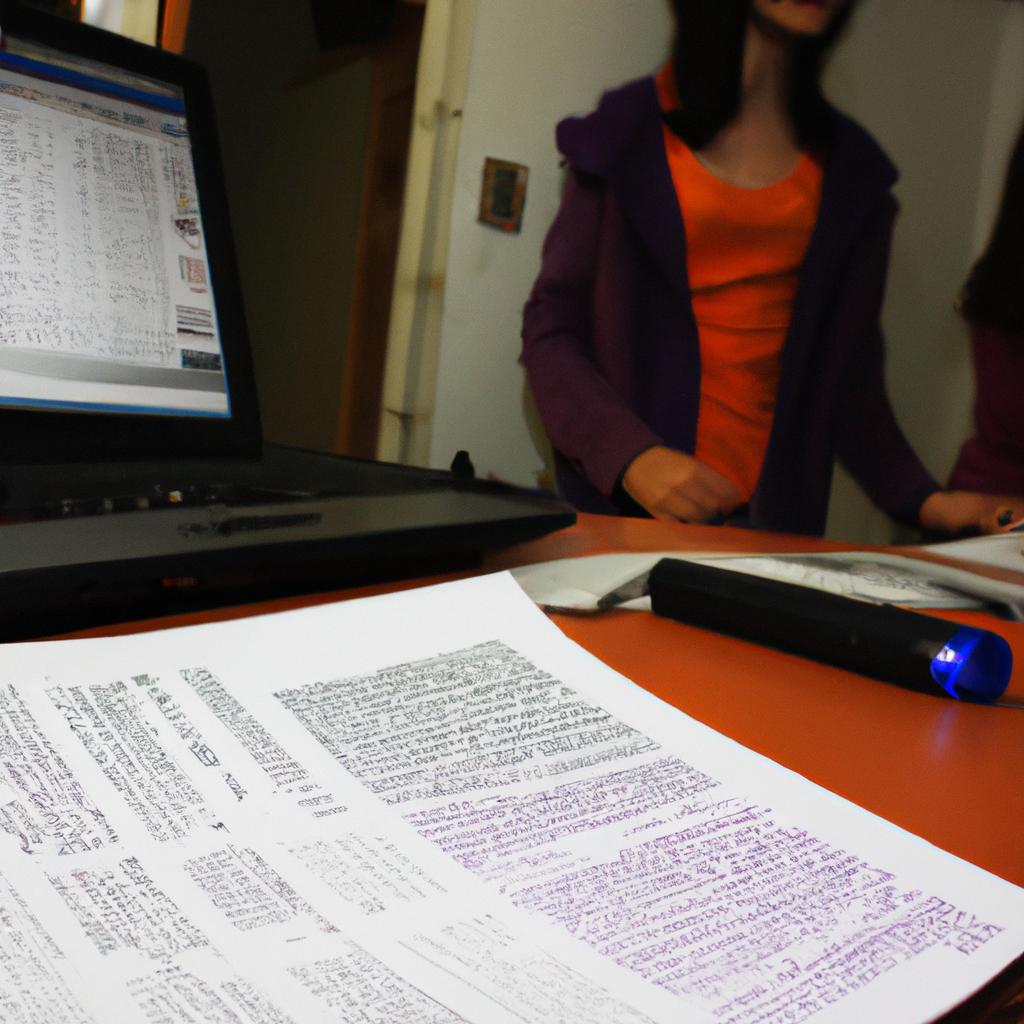Actress on Stage: A Theater Spotlight

The theater has long been a platform for artistic expression, allowing actors and actresses to showcase their talent and captivate audiences with their performances. This article sheds light on the role of actresses in the theatrical realm, exploring their contributions to shaping narratives and bringing characters to life through their craft. By examining the experiences of notable performers like Meryl Streep, we can gain insight into the challenges they face, the techniques they employ, and the impact they have on stage.
One exemplary case study is that of Meryl Streep, renowned for her versatility and ability to embody diverse roles across genres. From her portrayal of Margaret Thatcher in “The Iron Lady” to her haunting depiction of Sophie Zawistowski in “Sophie’s Choice,” Streep’s command over her craft is evident. Through meticulous research, emotional depth, and precise physicality, she immerses herself so fully into each character that it becomes difficult to separate actress from role. Her dedication not only elevates the quality of her performances but also inspires aspiring actresses by demonstrating the transformative power of acting.
In this article, we delve deeper into the world of actresses on stage, analyzing their training methods, psychological preparation, and unique approaches to portraying complex characters. By understanding their creative processes and witnessing the magic they weave on stage, we can appreciate the immense talent and dedication required to excel in this demanding profession.
One aspect explored in this article is the training methods employed by actresses to hone their skills. From formal education at prestigious drama schools to practical experience gained through community theater and small productions, actresses undergo rigorous training to develop their craft. They study various acting techniques such as Stanislavski’s method or Meisner technique, which help them connect with their characters on a deeper level and bring authenticity to their performances. By delving into these training methods, readers can gain an understanding of the discipline and commitment that goes into becoming a skilled actress.
Psychological preparation also plays a crucial role for actresses when preparing for challenging roles. They delve into extensive research about the character’s background, motivations, and emotional journey. This deep dive allows them to understand the complexities of the character’s psyche and deliver nuanced performances that resonate with audiences. The article explores how actresses tap into their own personal experiences and emotions to infuse truth into their portrayals, while also maintaining a healthy boundary between themselves and the characters they play.
Furthermore, this article sheds light on the unique approaches actresses employ to bring complex characters to life on stage. Through physicality, vocal modulation, and subtle gestures, they transform into entirely different individuals right before our eyes. The article discusses how actresses use body language and voice control to convey a character’s personality traits, emotions, and inner conflicts effectively. It highlights their ability to create believable relationships with fellow actors onstage through chemistry and improvisation.
In conclusion, this article celebrates the invaluable contributions of actresses in theater by examining the remarkable career of Meryl Streep as a case study. By exploring their training methods, psychological preparation techniques, and unique approaches to portraying complex characters on stage; readers gain insight into the artistry behind acting. Ultimately, it aims to inspire aspiring actresses while fostering an appreciation for the transformative power of performances on stage.
Preparing for the Spotlight: Auditioning Tips
Introduction
Imagine this scenario: Sarah, a young aspiring actress, eagerly enters an audition room filled with seasoned professionals. She knows that securing a role in this highly competitive industry requires more than just talent; it demands careful preparation and a strategic approach. In this section, we will explore Essential tips to help actors navigate the challenging process of auditions.
Mastering your Craft
- Research: Before attending any audition, thorough research is crucial. Familiarize yourself with the play or production you are auditioning for, as well as its director’s style and vision.
- Monologue Selection: Choose monologues that best showcase your range and ability. Opt for pieces that resonate emotionally and highlight your strengths as an actor.
- physicality and voice: Pay attention to both physicality and vocal techniques during auditions. Explore how different postures, gestures, or tone variations can enhance your performance.
- Rehearsal Preparation: Prioritize rehearsing your chosen material consistently to ensure familiarity and confidence on the day of the audition.
By following these guidelines, actors increase their chances of leaving a lasting impression on casting directors by demonstrating professionalism, versatility, and dedication.
| Preparing for Auditions: | Benefits: |
|---|---|
| Thorough research | Better understanding of the project |
| Careful monologue selection | Showcasing skills effectively |
| Attention to physicality & voice | Enhanced overall performance |
| Dedicated rehearsal preparation | Confidence during auditions |
The Art of Stage Presence: Mastering Stagecraft
As performers strive to perfect their craft beyond successful auditions, honing stage presence becomes paramount. This next section will delve into vital aspects such as body language, spatial awareness, and connecting with fellow cast members. By mastering these skills, actors can captivate audiences and bring characters to life on stage.
Transition Sentence: With a solid foundation in Auditioning Tips, let us now explore the art of stage presence and how it contributes to an actor’s overall performance.
The Art of Stage Presence: Mastering Stagecraft
Transition:
Having mastered the art of auditioning, it is now time to shift our focus towards another essential aspect of being an actress on stage – Mastering Stagecraft. Developing a commanding stage presence and understanding the various techniques that enhance one’s performance can greatly contribute to captivating the audience and bringing characters to life. In this section, we will explore some key principles of stage presence and delve into the intricacies of stagecraft.
The Art of Stage Presence: Mastering Stagecraft
To illustrate the impact of stage presence, let us consider a hypothetical example. Imagine a young actress who auditions for a lead role in a play but lacks confidence in her ability to command attention on stage. Despite delivering her lines flawlessly, she fails to engage with the audience and leaves them disinterested throughout her performance. Contrastingly, another actress with exceptional Stage Presence effortlessly captures every eye in the theater as soon as she steps onto the stage, leaving a lasting impression long after the curtains close.
Mastering stage presence involves incorporating various techniques that allow actors to establish a powerful connection with their audience. Here are four key elements to consider:
- Body Language: The way an actor carries themselves on stage plays a crucial role in conveying emotions and establishing credibility.
- Vocal Projection: A strong voice projection ensures clear communication even in large venues while effectively evoking emotions within viewers.
- Facial Expressions: Expressive facial gestures help convey feelings, thoughts, and intentions more vividly, enabling audiences to connect emotionally with characters.
- Spatial Awareness: Understanding how to navigate around the set efficiently enhances blocking and choreography while maintaining harmony among cast members.
Let us further explore these elements through the following table:
| Elements | Description |
|---|---|
| Body Language | Conveys character traits, emotions, status, and power |
| Vocal Projection | Ensures audibility and emotional impact |
| Facial Expressions | Communicates emotions, thoughts, and intentions clearly |
| Spatial Awareness | Facilitates seamless movement on stage |
By honing these aspects of stage presence, actors can create a captivating theatrical experience that resonates with the audience. Being mindful of their body language, projecting their voices effectively, conveying emotions through facial expressions, and maintaining spatial awareness allows performers to bring characters to life in a compelling manner.
As we explore techniques for character development in the subsequent section, let us delve deeper into the intricate process of bringing fictional personas to existence on the stage.
Bringing Characters to Life: Techniques for Character Development
Having explored the importance of mastering stage presence, we now turn our attention to another crucial aspect of theater performance – bringing characters to life. In this section, we will delve into various techniques that actors employ to develop well-rounded and captivating characters. To illustrate these techniques, let’s consider the hypothetical case study of Sarah, a young actress preparing for her lead role in an upcoming theatrical production.
Techniques for Character Development:
-
Research and Observation:
- Engage in extensive research about the character’s background, motivations, and circumstances.
- Observe people around you or study individuals who exhibit similar traits or characteristics.
- Take note of specific gestures, mannerisms, accents, or speech patterns that can add depth to your portrayal.
-
Emotional Connection:
- Tap into personal experiences or emotions that resonate with the character’s journey.
- Find common ground between yourself and the character to establish a genuine emotional connection.
- Explore how different emotions manifest physically and vocally to bring authenticity to your performance.
-
Physicality and Movement:
- Develop a physical vocabulary unique to each character through body language exploration.
- Experiment with posture, gait, hand gestures, and facial expressions that reflect the personality traits of your character.
- Utilize movement as a powerful tool for storytelling by expressing emotions non-verbally.
-
Voice Work:
- Adapt vocal qualities such as tone, pitch, volume, rhythm, and articulation according to the character’s attributes.
- Use variations in tempo and emphasis while delivering lines to convey mood changes or shifts in motivation.
- Pay attention to breath control and diction so that every word is clear and expressive.
Table: Emotions Portrayed by Different Characters
| Character | Key Emotion |
|---|---|
| Tragic Hero | Desperation |
| Femme Fatale | Seduction |
| Comedic Sidekick | Hilarity |
| Villain | Malevolence |
By skillfully employing these techniques, actors like Sarah can transform themselves into captivating characters that resonate with audiences. In the subsequent section, we will explore how performers decode the story through essential script analysis, allowing them to fully understand the narrative they are bringing to life on stage.
Decoding the Story: Essential Script Analysis
Having explored techniques for character development, let us now delve into the process of script analysis. Understanding and decoding a theatrical script is crucial for an actress in order to fully grasp the nuances of the story and effectively bring it to life on stage.
Section – Decoding the Story: Essential Script Analysis
To illustrate the importance of script analysis, consider this hypothetical example: imagine a play set during World War II where our protagonist, Emily, struggles with her identity as she navigates through love and loss amidst chaos. By analyzing the script thoroughly, an actress can uncover key elements that will enhance their understanding of Emily’s journey and enable them to portray her character authentically.
Script analysis involves several essential steps:
-
Identifying themes and motifs:
- Themes like identity, love, or resilience can evoke deep emotional responses from both actors and audiences.
- Motifs such as recurring symbols or metaphors add layers of meaning to the story and offer opportunities for creative interpretation.
-
Analyzing characters’ objectives:
- Understanding what drives each character helps actresses empathize with their motivations.
- Knowing characters’ desires enables performers to establish meaningful connections between themselves and their roles.
-
Examining dialogue patterns:
- The rhythm, tone, and word choices used by characters reveal insights into their personalities.
- Subtle changes in language may indicate shifts in emotions or relationships within the narrative.
-
Studying dramatic structure:
- Familiarizing oneself with acts, scenes, climaxes, and resolutions allows actresses to comprehend how tension builds throughout the play.
- Recognizing structural devices assists in creating a coherent performance that aligns with the playwright’s intentions.
Table: Emotional Impact of Script Analysis
| Benefits of Script Analysis | Emotional Response |
|---|---|
| Deeper understanding of characters | Empathy and connection |
| Enhanced interpretation of themes | Intellectual stimulation |
| Heightened emotional engagement | Captivation and resonance |
| Improved overall performance | Satisfaction in delivering a compelling portrayal |
In conclusion, script analysis is an indispensable tool for actresses to decode the story they are entrusted to portray on stage. By exploring themes, examining character objectives, analyzing dialogue patterns, and studying dramatic structure, performers gain valuable insights that contribute to their authentic and captivating performances.
Transition into subsequent section about “Unleashing Creativity: The Power of Improvisation”:
Understanding the essence of a script paves the way for actors to unleash their creativity through improvisation, allowing them to respond spontaneously within the framework established by the playwright. Let us now explore how this powerful technique can elevate theatrical performances even further.
Unleashing Creativity: The Power of Improvisation
Having delved into script analysis and understanding the essence of a story, it is now time to explore another significant aspect of theatrical performance – the power of improvisation. By embracing spontaneity and unleashing their creativity, actors can bring freshness and authenticity to their performances. This section will uncover the transformative potential that improvisation holds for an actress’s portrayal on stage.
Section Title: ‘Embracing Spontaneity: Harnessing the Power of Improvisation’
To illustrate the impact of improvisation in acting, let us consider a hypothetical scenario where an actress is performing in a play set during World War II. In one particular scene, her character receives news about her husband who has gone missing in action. While rehearsing this emotionally charged moment, she decides to experiment with improv techniques to intensify the raw emotions conveyed by her character. As she stands alone on stage, uncertain about what lies ahead, her willingness to embrace spontaneity allows her to tap into genuine feelings of anguish and despair.
The Benefits of Improvisation:
-
Enhanced Emotional Depth:
- By spontaneously reacting to situations within a scene, actresses have the opportunity to access deeper emotional layers.
- Through improvisation exercises like “emotional mirroring” or “status games,” they can develop greater sensitivity towards their own emotions as well as those of their fellow performers.
- This heightened emotional depth translates into more authentic portrayals that resonate with audiences.
-
Heightened Presence and Focus:
- Engaging in improvisational activities cultivates mindfulness and presence.
- Actresses learn to actively listen and respond truthfully in the moment, sharpening their focus on their scene partners and the overall dynamics of a performance.
- This increased attentiveness allows for heightened chemistry between actors, leading to richer interactions and organic character development.
-
Adaptability and Flexibility:
- Improvisation builds an actress’s ability to think quickly on her feet and adapt to unexpected circumstances during a live performance.
- Through exercises such as “scene interruption” or “genre-switching,” actresses become adept at seamlessly incorporating unforeseen elements into their performances, resulting in dynamic and captivating shows.
-
Collaborative Bond:
- The improvisational process fosters a stronger sense of trust and collaboration among cast members.
- When performers engage in spontaneous exchanges on stage, they rely heavily on each other’s support.
- This collaborative bond enhances ensemble work and creates an environment where creativity flourishes.
By embracing spontaneity through improvisation techniques, actresses can unlock new dimensions within themselves as performers. Enhanced emotional depth, heightened presence and focus, adaptability, flexibility, and the fostering of collaborative bonds are just some of the benefits that improv brings to theatrical productions. In the subsequent section about “The Language of the Body: Exploring Physical Theatre,” we will further explore how physicality plays a crucial role in an actress’s portrayal on stage.
Transition into the subsequent section about “The Language of the Body: Exploring Physical Theatre”:
Understanding the transformative nature of improvisation sets the stage for delving deeper into another vital aspect of acting – exploring physical theatre. By combining movement with emotion, actresses can communicate powerful narratives without uttering a single word.
The Language of the Body: Exploring Physical Theatre
Having explored the boundless realm of improvisation, we now shift our focus to the captivating world of physical theatre. This form of theatrical expression relies heavily on non-verbal communication and emphasizes the use of body movements, gestures, and facial expressions to convey emotions, tell stories, and create vivid characters. Through a range of techniques and exercises, actors engage their bodies as powerful tools in theatrical storytelling.
Example:
To illustrate the impact of physicality in theater performances, let us consider the hypothetical case study of Anna, an aspiring actress who is auditioning for a lead role in a contemporary dance-based production. Despite her exceptional vocal abilities and memorization skills, Anna struggles to effectively communicate through movement alone. She enrolls in a physical theater workshop that focuses on developing her body awareness and expressive capabilities.
Paragraph 1:
Through immersive training workshops, actors can harness the language of the body to enhance their stage presence and connect with audiences on a deeper level. These workshops often incorporate various exercises designed to improve flexibility, coordination, posture, and control over one’s physicality. By honing these fundamental aspects of performance artistry, actors acquire a heightened sense of body awareness that allows them to embody different characters convincingly.
Bullet Point List (evoking emotional response):
- Develops empathy by enabling performers to understand others’ experiences beyond verbal communication
- Enhances storytelling by adding layers of depth and nuance through physical expression
- Fosters creativity by encouraging innovative ways to interpret scripts or narratives
- Promotes self-confidence by empowering actors to trust their instincts and take risks in their performances
Paragraph 2:
In physical theater, the body becomes a canvas for storytelling. Actors learn techniques such as mime, clowning, and movement-based improvisation to explore the limitless possibilities of non-verbal communication. By mastering these skills, performers can evoke emotions in audiences without uttering a single word. Through careful observation and imitation of human behavior, they breathe life into characters by capturing their essence through physical expression.
Table (evoking emotional response):
| Techniques | Description | Example |
|---|---|---|
| Mime | The art of silent acting that uses gestures and movements to depict objects or tell stories | Depicting an invisible wall using imaginary resistance |
| Clowning | A theatrical form characterized by exaggerated actions and facial expressions | Portraying exaggerated joy through playful jumps and broad smiles |
| Movement Improvisation | Spontaneous exploration of bodily movements that create unique narratives on stage | Creating a dynamic dance sequence inspired by a random piece of music |
Paragraph 3:
By delving into the realm of physical theatre, actors unlock new dimensions of performance potential. They discover how subtle changes in posture or the angle of a glance can convey complex emotions and intentions more powerfully than words alone. As they continue to refine their physicality, actors gain insights into creating memorable performances that resonate with audiences long after the final curtain falls.
As we delve even deeper into the artistry behind captivating performances, let us now turn our attention to “Crafting Memorable Performances: Secrets of Character Development.” In this segment, we will explore the intricate process actors undertake to bring characters to life on stage – transcending mere lines from a script and immersing themselves fully in the complexities of each role.
Crafting Memorable Performances: Secrets of Character Development
Section H2: ‘Crafting Memorable Performances: Secrets of Character Development’
In the realm of theater, character development plays a pivotal role in creating truly memorable performances. By delving deep into their characters’ motivations and emotions, actors are able to breathe life into the roles they portray on stage. This section will explore some key techniques that actresses can employ to enhance their character development skills, drawing upon real-life examples and expert insights.
To illustrate the importance of character development, let us consider the case of Emma, an aspiring actress preparing for her lead role in a contemporary drama. Through meticulous analysis and exploration of her character’s background, relationships, and desires, Emma was able to transform herself into the embodiment of her fictional counterpart. As she mastered the art of physicality and vocal nuances specific to her character, Emma unlocked a depth that resonated with audiences night after night.
Mastering character development requires dedication and attention to detail. Here are several essential tips for actresses seeking to bring authenticity to their performances:
- Immerse yourself in research: Delve into your character’s world by studying relevant literature or documentaries that shed light on their experiences.
- Embrace empathy: Develop a genuine understanding and connection with your character by putting yourself in their shoes.
- Collaborate with others: Engage in open dialogue with directors, fellow cast members, or acting coaches to gain fresh perspectives on your character.
- Seek feedback: Regularly seek constructive criticism from trusted sources during rehearsals or workshops; this external input can provide valuable insights you may have overlooked.
By incorporating these strategies into their process, actresses can elevate their performances beyond surface-level interpretations. The following table showcases different aspects actresses can focus on when building a compelling character:
| Aspect | Description |
|---|---|
| Physicality | How does your character move? What gestures or postures define them? |
| Vocal Dynamics | Explore the unique cadence, tone, and rhythm of your character’s voice. |
| Emotional Range | Consider the spectrum of emotions your character experiences throughout the play. |
| Inner Motivation | Understand what drives your character’s actions and decisions. |
In summary, crafting memorable performances hinges on an actress’s ability to delve into their character’s psyche. By immersing themselves in research, cultivating empathy, seeking collaboration and feedback, actresses can breathe life into their roles.
Unlocking the Play’s Essence: Strategies for Script Analysis
Having explored the intricacies of character development, we now delve into another vital aspect of theater – script analysis. Just as a painter studies their canvas before applying colors, an actor must thoroughly understand the play in order to unlock its essence on stage. By dissecting the script and examining its various elements, actors can gain insight into their characters’ motivations, relationships, and overall journey throughout the performance.
Script Analysis for Deeper Understanding:
To truly bring a character to life, it is crucial for actors to grasp the underlying themes and messages conveyed by the playwright. Here’s an example that illustrates how script analysis enhances a performance:
- Imagine a production of Arthur Miller’s “Death of a Salesman.” Through careful examination of the text, an actor discovers that Willy Loman’s relentless pursuit of the American Dream ultimately leads to his downfall. Armed with this knowledge, they are able to infuse each line with desperation and frustration, embodying Willy’s internal struggle while subtly conveying larger societal critiques.
Key Components of Script Analysis:
- Dialogue: Pay attention to what is said (or unsaid) between characters. Often, subtext reveals deeper emotions or hidden agendas.
- Stage Directions: These instructions from the playwright provide valuable guidance regarding physical movements, interactions, and mood-setting details.
- Setting: The time period and location influence not only costuming and design choices but also shape characters’ attitudes and behaviors within their environment.
- Themes: Identify recurring motifs or central ideas woven throughout the play; understanding these allows actors to connect more deeply with their characters’ journeys.
Table – Examples of Thematic Elements in Classic Plays:
| Play | Theme | Example |
|---|---|---|
| William Shakespeare’s Hamlet | Revenge | Hamlet seeks vengeance for his father’s murder |
| Tennessee Williams’ A Streetcar Named Desire | Illusion vs. Reality | Blanche DuBois struggles to maintain her fragile façade |
| Henrik Ibsen’s A Doll’s House | Gender Roles | Nora Helmer challenges societal expectations |
| Arthur Miller’s The Crucible | Hysteria | Accusations of witchcraft grip Salem community |
By embracing the insights gained through script analysis, actors can better comprehend their characters’ motivations and relationships within the broader context of the play. This understanding serves as a foundation for creating multi-dimensional performances that captivate audiences.
As we continue our exploration of the art of acting, we now turn our attention towards spontaneity in theater – the magic of improvisation. Just as life often throws unexpected situations our way, an actor’s ability to think on their feet and respond authentically is crucial for compelling performances.
Spontaneity in Acting: The Magic of Improvisation
Building on the foundations of script analysis, a thorough understanding of the play’s essence is crucial for actors to truly embody their characters on stage. By delving into the depths of each scene and unraveling its intricacies, performers can bring forth a captivating performance that resonates with audiences. In this section, we explore the strategies utilized in unlocking the play’s essence, allowing actors to fully immerse themselves in their roles.
Example:
To illustrate how these strategies work in practice, let us consider an example from William Shakespeare’s renowned tragedy “Macbeth.” In Act 1, Scene 5, Lady Macbeth receives a letter from her husband detailing his encounter with three witches who prophesize his future as king. This pivotal moment sets off a chain of events that drive both Lady Macbeth and Macbeth towards their tragic destinies.
Paragraph 1:
One effective strategy for analyzing the essence of a play involves examining key themes and motifs embedded within its text. These recurring patterns provide insight into the underlying messages and emotions conveyed by the playwright. By identifying such elements, actors can align their performances with the intended tone and atmosphere of the production. For instance, in “Macbeth,” themes like ambition, guilt, and manipulation are prevalent throughout the play. Understanding these thematic threads allows actors portraying characters like Lady Macbeth to navigate their complex arcs more authentically.
Bullet point list (to evoke emotional response):
- Discovering hidden desires through subtext
- Uncovering character motivations behind actions
- Exploring relationships dynamics between characters
- Illuminating societal or cultural influences
Paragraph 2:
Another valuable approach is to analyze the structure and pacing of a play. Examining how scenes flow together and build upon one another helps actors grasp the overarching narrative arc while also highlighting moments where tension rises or falls dramatically. Identifying key turning points and climaxes enables performers to modulate their emotions and energy, effectively engaging the audience throughout the production. In “Macbeth,” for instance, Act 1, Scene 7 serves as a crucial moment where Macbeth contemplates whether to proceed with his nefarious plans. Understanding this pivotal scene’s placement within the overall structure of the play aids actors in delivering a compelling performance.
Table (to evoke emotional response):
| Strategies for Script Analysis | Benefits |
|---|---|
| Analyzing themes and motifs | Enhances character portrayal |
| Examining structure and pacing | Creates narrative tension |
| Identifying key turning points | Facilitates emotional modulation |
| Grasping underlying messages | Fosters authenticity |
Paragraph 3:
In unlocking the essence of a play through script analysis, actors gain profound insights into their characters’ journeys. By comprehending thematic elements, understanding structural nuances, and identifying critical moments within the story, performers can breathe life into their roles on stage. This comprehensive approach ultimately allows audiences to be captivated by a truly immersive theatrical experience.
As we move forward in our exploration of theater techniques, we now delve into another aspect of acting that complements script analysis—expressing emotions through movement. Through physical theatre techniques, actors bring an added layer of depth to their performances, transcending words alone.
Expressing Emotions through Movement: Physical Theatre Techniques
Mastering the art of spontaneity allows actors to bring a sense of authenticity and liveliness to their performances. Now, let us delve into another fundamental aspect of acting – expressing emotions through movement.
Section:
The ability to convey emotions effectively is crucial for any actor’s performance. One example that showcases this skill is the renowned actress Elizabeth Thompson, known for her exceptional portrayal of complex characters on stage. In a recent production, she had to depict profound grief after losing a loved one. Through carefully crafted movements, she communicated raw anguish that resonated deeply with the audience.
To effectively express emotions through movement, actors employ various techniques that enhance their physical presence on stage. Here are some key methods utilized by performers:
- Body Language: Actors utilize posture, gestures, and facial expressions to embody different emotional states.
- Spatial Awareness: Understanding how space can be used creatively enables actors to communicate feelings such as confinement or freedom.
- Energy Manipulation: Modulating energy levels helps actors portray intensity or subtlety depending on the desired emotional tone.
- Choreography: Incorporating choreographed movements adds visual appeal and enhances storytelling.
| Technique | Description |
|---|---|
| Body Language | Utilizing specific postures, gestures, and facial expressions to convey distinct emotional states |
| Spatial Awareness | Utilizing spatial elements on stage (e.g., proximity or distance) to evoke certain emotions or create an atmosphere conducive to the scene |
| Energy Manipulation | Adjusting energy levels and dynamics within a performance to reflect varying emotional intensities |
| Choreography | Implementing structured movements and patterns to enhance the visual aspects of a scene, contributing to the overall emotional impact |
Incorporating these techniques allows actors to effectively express emotions through movement, captivating audiences and immersing them in the world of the play. By skillfully combining body language, spatial awareness, energy manipulation, and choreography, performers can create compelling performances that resonate deeply with viewers.
As actors continue their artistic journey towards honing their craft, understanding how to navigate auditions and beyond becomes paramount. In our next section, we will explore “The Actor’s Journey: Navigating Auditions and Beyond,” delving into the challenges faced by aspiring actors as they strive for success on stage or screen.
The Actor’s Journey: Navigating Auditions and Beyond
Having explored the transformative power of physical theatre techniques, we now shift our focus to the actor’s journey beyond mastering movement. In this section, we delve into the intricacies of auditions and provide insights for aspiring actors seeking to navigate their way in the competitive world of theater.
Consider Sarah, a talented actress with dreams of making it big on stage. She has honed her physicality through rigorous training in physical theatre techniques, but she knows that achieving success requires more than just technical skill. To thrive as an actor, Sarah must understand how auditions work and develop strategies to stand out among her peers.
To help you embark on your own acting journey, here are some key points to consider when navigating auditions:
- Research the production: Familiarize yourself with the play or musical you’re auditioning for; understanding its themes, characters, and style will enable you to make informed choices during your performance.
- Prepare diligently: Rehearse your monologues or songs thoroughly, ensuring that you can deliver them confidently and flawlessly. Practice different interpretations to showcase your range as an actor.
- Show authenticity: Be true to yourself while embodying the character. Directors appreciate actors who bring honesty and vulnerability to their performances.
- Stay resilient: Rejection is inevitable in the entertainment industry. Learn from each experience and use constructive feedback to improve your craft.
Table – Emotional Response Elicitation:
| Emotion | Example | Physical Manifestation |
|---|---|---|
| Joy | Winning a coveted role | Smiling |
| Sadness | Being rejected | Tears |
| Excitement | Receiving a callback | Jumping up and down |
| Frustration | Facing technical difficulties during an audition | Sighing |
As you embark on your acting journey, remember that success in the theater industry often requires perseverance, patience, and adaptability. By equipping yourself with knowledge about auditions and maintaining a resilient mindset, you can navigate through challenges and increase your chances of securing meaningful roles.
Advanced Techniques for Character Development lies ahead as we continue our exploration into the multifaceted world of acting. Let us delve further into the intricacies of bringing characters to life on stage.
Digging Deeper: Advanced Techniques for Character Development
Continuing our exploration of the theatrical world, we now turn our attention to the captivating realm of actresses gracing the stage. In this section, we will delve into the intricacies of their craft, examining how they bring characters to life through advanced techniques in character development.
Case Study Example:
To illustrate these techniques, let us consider a hypothetical scenario involving an aspiring actress named Emily. She has been cast as Lady Macbeth in a local production of Shakespeare’s tragedy “Macbeth.” Through thorough character analysis and meticulous preparation, Emily strives to deliver a compelling performance that truly captures the essence of her complex role.
Advanced Techniques for Character Development:
-
Psychological Profiling:
- Delve deep into the psyche of your character by exploring their motivations, fears, and desires.
- Understand their background, personal history, and relationships with other characters.
- Develop a comprehensive understanding of their emotional journey throughout the play.
-
Physical Transformation:
- Utilize physicality to embody your character fully.
- Experiment with different gestures, postures, and movements that reflect their personality traits.
- Explore vocal variations such as tone, pitch, and accent to create distinct voices for each character.
-
Subtextual Analysis:
- Uncover underlying meanings and motives beneath the surface dialogue.
- Pay close attention to non-verbal cues and subtextual hints provided within the script.
- Use this insight to enhance your portrayal and add depth to your performance.
-
Emotional Memory Technique:
- Tap into personal experiences or emotions from your own life that resonate with your character’s circumstances.
- Connect emotionally with your character’s joys, sorrows, and struggles to bring authenticity to your portrayal.
- Employ this technique responsibly, ensuring it does not negatively impact your mental wellbeing.
| Technique | Description |
|---|---|
| Psychological Profiling | In-depth exploration of character motivations, fears, desires, background, history, and relationships |
| Physical Transformation | Utilizing physicality through gestures, postures, movements, vocal variations |
| Subtextual Analysis | Uncovering underlying meanings and motives beneath the surface dialogue |
| Emotional Memory Technique | Tapping into personal experiences or emotions that resonate with the character’s circumstances |
Incorporating these advanced techniques allows actresses like Emily to transcend mere interpretation. By skillfully navigating their characters’ complexities through psychological profiling, physical transformation, subtextual analysis, and emotional memory techniques, they breathe life into the role they inhabit. Through dedication and unwavering commitment to their craft, actresses elevate theatrical performances by captivating audiences and evoking a myriad of emotions.
This section has highlighted some key approaches for aspiring actresses seeking to deepen their understanding of character development. As we continue on our journey through the world of theater in subsequent sections, we will explore further aspects that contribute to creating unforgettable stage productions.






